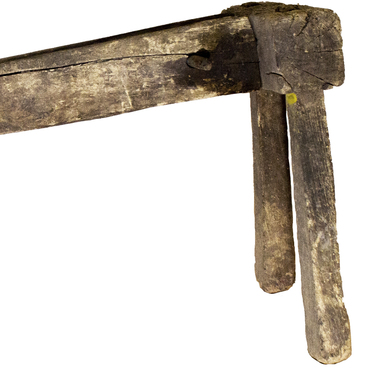The first spring clock was created by an unknown master for the Duke of Burgundy Philip the Good around 1430. This table clock was made of bronze; its height reached half a meter.
The first portable mechanical clocks with a spring mechanism were made of brass in the form of a round or square box with a horizontal clock face. The clock was marked with engraved Roman numerals with convex brass “grains” (balls) in a circle, by which it was possible to determine the time in the dark by touch. There was only one hand, often it was made in the form of a fantastic creature, for example, a dragon or a mermaid.
Table clocks with the case in form of medieval towers appeared later, by the end of the 15th century. They were equipped with one hand, too, but there were two faces: one face to show the time and the second face to set up the alarm clock.
Before the appearance of screws, iron parts of mechanisms were connected with the help of pins and wedges. The winding spring was a long and wide steel band. It could not work without an auxiliary mechanism that equalized its driving force. For this purpose, a fusee was used — a brass truncated cone, on which a string of catgut (sheep intestines) or a flat metal chain of 500 or more links was wound.
The mechanisms of early spring clocks had a spindle stroke. Such clocks did not have a pendulum, and as a stroke regulator, they used a foliot — a horizontal bar with a weight at each end, which, however, did not ensure the accuracy of the stroke. The hour hand could make a daily error of 30 minutes or even more.
The Dutch mechanic Christiaan Huygens solved this problem. In 1657, he received a patent for the design of a pendulum clock. The central part was the anchor, which periodically pushed the pendulum and supported its steady undamped oscillations.
Huygens studied the features of the pendulum for about 40 years and tried to improve it. His goal was to adapt a pendulum clock to determine longitude at sea, but he did not succeed. The English watchmaker John Harrison invented a reliable and accurate marine chronometer only in 1735.
The first portable mechanical clocks with a spring mechanism were made of brass in the form of a round or square box with a horizontal clock face. The clock was marked with engraved Roman numerals with convex brass “grains” (balls) in a circle, by which it was possible to determine the time in the dark by touch. There was only one hand, often it was made in the form of a fantastic creature, for example, a dragon or a mermaid.
Table clocks with the case in form of medieval towers appeared later, by the end of the 15th century. They were equipped with one hand, too, but there were two faces: one face to show the time and the second face to set up the alarm clock.
Before the appearance of screws, iron parts of mechanisms were connected with the help of pins and wedges. The winding spring was a long and wide steel band. It could not work without an auxiliary mechanism that equalized its driving force. For this purpose, a fusee was used — a brass truncated cone, on which a string of catgut (sheep intestines) or a flat metal chain of 500 or more links was wound.
The mechanisms of early spring clocks had a spindle stroke. Such clocks did not have a pendulum, and as a stroke regulator, they used a foliot — a horizontal bar with a weight at each end, which, however, did not ensure the accuracy of the stroke. The hour hand could make a daily error of 30 minutes or even more.
The Dutch mechanic Christiaan Huygens solved this problem. In 1657, he received a patent for the design of a pendulum clock. The central part was the anchor, which periodically pushed the pendulum and supported its steady undamped oscillations.
Huygens studied the features of the pendulum for about 40 years and tried to improve it. His goal was to adapt a pendulum clock to determine longitude at sea, but he did not succeed. The English watchmaker John Harrison invented a reliable and accurate marine chronometer only in 1735.



